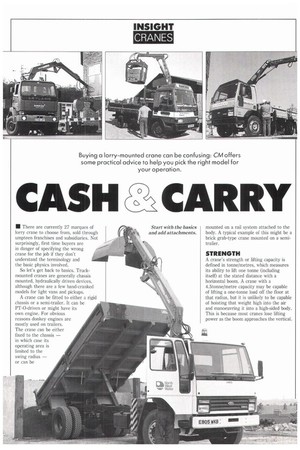CASH CARRY
Page 36

If you've noticed an error in this article please click here to report it so we can fix it.
• There are currently 27 marques of lorry crane to choose from, sold through umpteen franchises and subsidiaries. Not surprisingly, first time buyers are in danger of specifying the wrong crane for the job if they don't understand the terminology and the basic physics involved.
So let's get back to basics. Truckmounted cranes are generally chassis mounted, hydraulically driven devices, although there are a few hand-cranked models for light vans and pickups.
A crane can be fitted to either a rigid chassis or a semi-trailer. It can be PT-ID-driven or might have its own engine. For obvious reasons donkey engines are mostly used on trailers. The crane can be either fixed to the chassis — in which case its operating area is limited to the swing radius — or can be
mounted on a rail system attached to the body. A typical example of this might be a brick grab-type crane mounted on a semitrailer.
STRENGTH
A crane's strength or lifting capacity is defined in tonne/metres, which measures its ability to lift one tonne (including itself) at the stated distance with a horizontal boom. A crane with a 4.5tonneknetre capacity may be capable of lifting a one-tonne load off the floor at that radius, but it is unlikely to be capable of hoisting that weight high into the air and manoeuvring it into a high-sided body. This is because most cranes lose lifting power as the boom approaches the vertical.




















































































